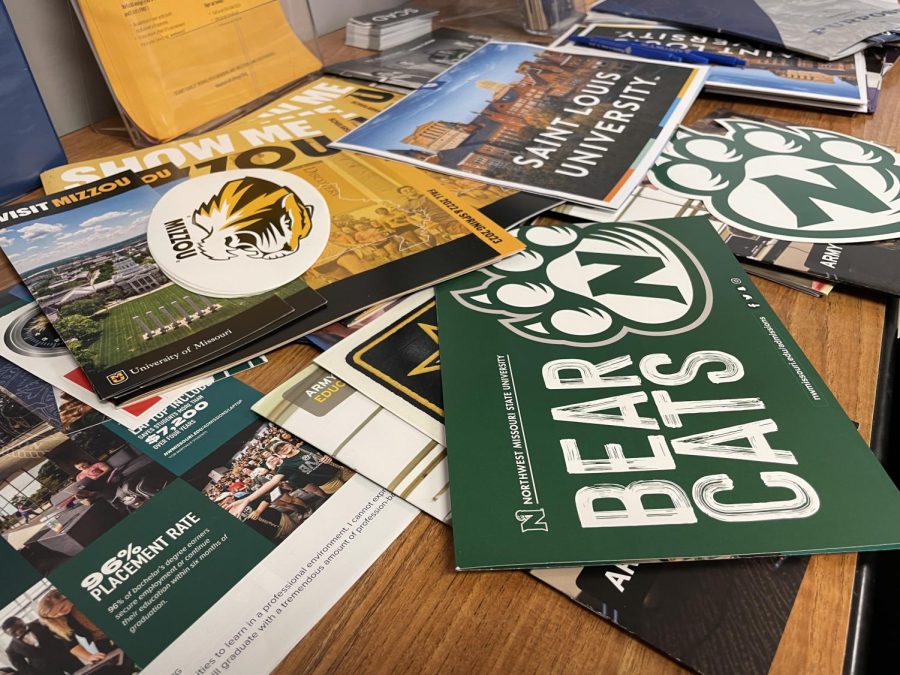Why College is Overrated, Overpriced, and Outdated [Opinion]
Credit to Macy Cronin
Various college brochures sit scattered in a pile across a table.
During the months of August through January the career and counseling center was available for drop-ins related to college. Scholarships were blasted to every senior and announcements were made daily of visits to Francis Howell North from different admissions offices of colleges. Yet through it all, where were the advertisements of postsecondary education for going into blue-collar work? Our school’s emphasis on a system that is overrated, overpriced, and overstressed needs to be revamped to be supportive of every student’s learning environment.
Every year, 19.4 million students attend college across the United States. The build-up towards the college application process is intense. Discussions of what colleges you’re considering, where you want to go and what you want to fill the hallways and everyday classroom chatter. Yet, the decisions seem to be focused on a select few colleges. Too much pressure is focused on the top-ranked universities rather than finding a college that fits your needs and your budget. The vast majority of students would perform well at nearly all schools.
Yet, the reality of the situation doesn’t quite fare the same as the expectation. Applications at all universities are up, but especially universities that are more well known across the United States. The problem is the competitiveness of these schools. We focused on so many in-state schools that information related to universities and trade schools that were outside of St. Louis was never dispersed.
Now, that’s not to say it’s possible to advertise every single university spread across the United States, however, it would be possible to push people more in the direction that they might be more suitable for. For example, meeting with students and advising each individual student at least once during their senior year. This would allow students to get their questions and advice in a timely manner.
However, because of the lack of information for many kids, college often turns into an endeavor that is much more expensive than it needs to be. According to Education Data, the average cost of attendance in-state for tuition is $10,740 and $27,560 for out-of-state students. Prices increasingly go up. However, a lot of the scholarships that are handed out at these universities are exclusive to those schools. Therefore, while the career counseling scholarship blasts can be helpful, the real necessity is one-on-one counseling on what to write and how to apply ourselves to the applications that we do for those individual schools we will attend.
Most of the scholarships that would help students afford high out-of-pocket costs associated with colleges outside of Missouri are ones that are only offered by the institution they will be attending. Meeting with an advisor at least once is an opportunity that is often underutilized and should be explained more to students throughout the process to allow them to afford the colleges that they want to go to both in-state or out-of-state.
Lastly and most importantly to create a life post high school, is to make sure all of your students feel like their interests are being explored through the opportunities that are presented to them. There are programs such as CAPS that are offered in our schools for those that are going into a route that doesn’t include college. However, this doesn’t do enough to actually advertise those sorts of options. While CAPS is advertised only about once or twice over all four years, college is advertised nearly every year.
This is purely anecdotal, however, in all my years at this school, I only knew personally two people who participated in any of those sorts of programs. We as a community have stressed far too much over college and it’s harming students’ mental health while not even benefitting all students. It’s okay to not go to a college, it’s okay to take a gap year, and it’s okay to go into any other route that’s not related to college.
Having a meeting one-on-one with individual students would allow them to feel comfortable sharing those concerns that they have over college or their lack of desire to attend one. According to NYU, this is the leading cause of stress, with 55% of students stressed due to academics. We have to give that chance for students to feel more comfortable making a decision that isn’t always well advertised.
Our college and career counselor works tirelessly to try and help our students with everything they need. But the very nature of it means that we as a school need to do more. We need more funding and we need more individualized attention, or college and other opportunities will continue to overwhelm students.
Your donation will support the student journalists of Francis Howell North High School. Your contribution will allow us to purchase equipment and cover our annual website hosting costs.







![Banning Bitter Truths [Opinion]](https://FHNtoday.com/wp-content/uploads/2025/03/A5420F3C-5A62-4390-A0DE-112E5DAFB16D-e1743114102833-600x564.jpg)
![Si Pudiera Devolver el Tiempo [Personal Column]](https://FHNtoday.com/wp-content/uploads/2025/03/Untitled-design-600x338.png)
![Solve the Real Problems Instead of Banning Phones [Editorial]](https://FHNtoday.com/wp-content/uploads/2025/03/Untitled_Artwork-1-e1742221427133-600x343.jpg)
![A Mock Trial Christmas [Personal Column]](https://FHNtoday.com/wp-content/uploads/2025/03/Copy-of-Mckenna-Hudson-Tales-of-a-child-delinquent-6-600x400.png)
![A Visit Inside An Artist's Mind [Personal Column]](https://FHNtoday.com/wp-content/uploads/2025/03/Copy-of-Mckenna-Hudson-Tales-of-a-child-delinquent-5-600x400.png)